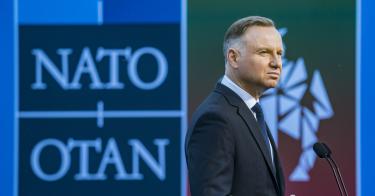The nuclear mission of the North Atlantic Treaty Organization is a legacy of the Cold War as currently postured. Weapons are stored in Belgium, Germany, Italy, Turkey, and the Netherlands—far from Russia’s borders.
Poland’s prime minister recently requested to be part of the NATO mission, known as nuclear burden sharing, that stores and may deliver nuclear weapons in times of crisis. While there would be costs and benefits to such a development that need to be weighed, Poland’s proposal is a serious one. It could give NATO the long-overdue opportunity to strengthen deterrence in Europe through an updated nuclear posture.
What Is NATO Nuclear Burden Sharing?
In the nuclear burden-sharing mission, a small number of American nuclear gravity bombs are stationed at NATO bases in Europe. Allied pilots are trained by American instructors in such training activities to drop the nuclear weapons and fly their nations’ nuclear-capable fighter bombers. The weapons are stored in secure sites and may be employed only through the consent of the NATO North Atlantic Council and the American president.
In short, these are American weapons that allied pilots can deliver. As of today, only those states that joined NATO before the fall of the Berlin Wall store and may deliver American nuclear weapons under the NATO burden-sharing agreement.
>>> NATO’s Nuclear Posture Needs Updating
The goals of the mission, which originated in the Cold War, are to deter aggression, particularly nuclear aggression, against NATO allies; assure allies that the American nuclear guarantee is credible; strengthen the alliance politically by making the nuclear-strike mission an alliance-wide activity; and signal resolve that NATO will not be intimidated by nuclear coercion. This is all done by providing a visible, geographic distribution and demonstration of NATO’s nuclear capabilities.
On June 30, following the conclusion of a two-day European Council summit, Polish Prime Minister Mateusz Morawiecki held a press conference at which he said that “in connection with the fact that Russia intends to deploy tactical nuclear weapons in Belarus, we ask the entire NATO to take part in the nuclear sharing program.”
He went on to say that “the final decision will depend on our American and NATO partners. We declare our will to act quickly…We do not want to sit idly by while [Russian President Vladimir] Putin builds up his threats of various kinds.”
Later that day, U.S. National Security Council spokesman John Kirby responded to the prime minister’s request by saying, “I have nothing to say about any conversations of this type. And, either way, we’re just not talking about deploying our nuclear systems, so I’m certainly not going to start doing that today.” With such a short, off-the-cuff comment, it seems that the White House dismissed the request out of hand, without giving it any meaningful consideration.
The Benefits of Polish Participation in Nuclear Burden Sharing
If we do the analysis, the benefits to an expansion of the burden sharing mission become apparent.
The benefits of Poland hosting nuclear weapons align with the initial reasons for and continued benefits of forward-basing American nuclear weapons in European states. In the Cold War, nuclear storage sites were near the front lines between NATO and the Warsaw Pact. This meant that NATO aircraft would be able to strike Soviet and Warsaw Pact targets quickly should the Soviets invade NATO states. These weapons provided a credible counter to the Warsaw Pact’s quantitative military might and thereby convinced the Soviet Union not to invade Western Europe. They were tools of deterrence.
This same logic applies today. Fighter-bombers armed with low-yield nuclear weapons are meant to deter aggression by presenting a credible combination of will and capability. Forward-basing such systems in the eastern parts of NATO would demonstrate a credible and stable deterrent posture.
Given that Russia announced in July that it moved some of its nuclear weapons into Belarus, a reciprocal announcement that NATO is considering a reposturing of its own nuclear forces should not be seen by Moscow as provocative or escalatory.
During the Cold War, stationing American weapons in Germany, Belgium, Italy, and elsewhere reduced the incentives of those countries to develop their own nuclear weapons. As a nonproliferation tool, nuclear burden-sharing could again prove effective at reducing the incentives for NATO allies to pursue their own nuclear capabilities.
Most important, expanding the nuclear burden-sharing mission to those states that joined NATO after the end of the Cold War would signal that NATO is not a moribund institution, unable to adapt to changing threat environments. It would show that NATO can adapt to changes in the security environment in meaningful ways.
Repositioning some nuclear weapons from Belgium, Germany, and the Netherlands may reduce a point of political friction in those countries, where non-majority but significant portions of the population have long opposed nuclear weapons on their soil.
Further, stationing nuclear weapons in bases in Belgium, Germany, Italy, Turkey, and the Netherlands made sense during the Cold War. Those nations were near the “frontlines” of the Warsaw Pact–NATO standoff. However, with the breakup of the Soviet empire and enlargement of NATO to the Baltics, Finland, and Poland, those bases are now several hundred miles farther from Russian forces.
Moving some nuclear weapons out of Germany, the Netherlands, and, potentially, Belgium and into NATO allies closer to Russia—say, Finland, Poland, and Romania—could accomplish three things simultaneously. First, reduce a point of friction caused by the presence of nuclear weapons in Belgium, Germany, and the Netherlands. Second, assure those NATO allies closest to Russia that the arsenal remains credible and effective. Finally, it would better dissuade Russian aggression by increasing the relevance of the nuclear deterrent.
Indeed, should a state such as Belgium or the Netherlands ask the United States at some future point to remove its nuclear weapons from that nation’s soil, having Poland or another Eastern European NATO ally prepared to take over the responsibility might be a prudent risk-mitigation measure.
>>> Forging the Future of NATO
Given the lack of Russian threat to NATO in the 20 years after the end of the Cold War, it was unnecessary to change the nuclear burden-sharing status quo. But as Russia increasingly engages in provocative and dangerous behavior—including repeated attempts at nuclear coercion against NATO states—the expansion of the nuclear burden-sharing mission to the east could signal to Russia that NATO remains a dynamic and resilient organization.
Toward a More Adaptive and Credible Deterrent
It should be noted that NATO’s Vilnius Summit Communique, issued in July 2023, indicated that NATO is ready to consider a more adaptive and flexible nuclear profile:
NATO will take all necessary steps to ensure the credibility, effectiveness, safety and security of the nuclear deterrent mission. This includes continuing to modernize NATO’s nuclear capability and updating planning to increase flexibility and adaptability of the Alliance’s nuclear forces…. The Alliance reaffirms the imperative to ensure the broadest possible participation by Allies concerned in NATO’s nuclear burden-sharing arrangements to demonstrate Alliance unity and resolve.
Therefore, the U.S. Departments of Defense and State, in conjunction with the NATO Nuclear Planning Group, should ensure that NATO’s deterrent posture is optimized to address 21st-century challenges. They should take a few key steps:
- Examine current deterrence requirements. This effort should include an analysis of updated capabilities and nuclear postures in order to ensure flexibility, adaptability, and, ultimately, the credibility of NATO’s nuclear forces.
- Analyze the pros and cons of expanding and/or reassigning the nuclear burden-sharing mission. The Vilnius Summit Communique provided guidance to NATO’s planning staff regarding the broadening of the nuclear burden-sharing mission, but NATO staff cannot do this work alone. The U.S. Departments of State and Defense should support this analysis.
- Consult with existing alliance members on their long-term desire to participate in the burden-sharing mission. NATO staff members and planners should use the Polish prime minister’s request as well as the Vilnius Communique as an opportunity to engage with alliance members who wish to reduce their roles in the nuclear burden-sharing mission. This is not to presuppose any specific outcome, such as the removal of nuclear weapons from legacy nuclear burden-sharing alliance members. But any reposturing of NATO’s nuclear deterrent should incorporate the views of not only those who wish to join the nuclear mission, but also those who may wish to reduce their roles in such a mission.
The Path Forward
The Polish request to take a central role in NATO’s nuclear burden sharing mission is worthy of consideration and should be examined with the utmost seriousness. Kirby’s seemingly out-of-hand dismissal of the proposal should not be the last word on the topic. The U.S. Mission to NATO should bring this issue up in discussions with the NATO Nuclear Planning Group for further analysis. Congress, through the National Defense Authorization Act, should at the same time request that the Air Force identify the impacts to deterring Russian aggression of such a re-posturing of NATO nuclear forces. The stakes are too great to do otherwise—and the time to modernize NATO’s decades-old deterrent posture may be here.
This piece originally appeared in 1945


